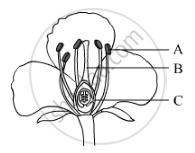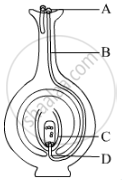Advertisements
Advertisements
प्रश्न
Sketch the labeled diagram:
Flower with its sexual reproductive organs
उत्तर
Flower with its sexual reproductive organs

APPEARS IN
संबंधित प्रश्न
Name the parts A, B and C shown in the following diagram and state one function of each.

A student has to perform the experiment "To identify the different parts of an embryo of a dicot seed." Select from the following an appropriate group of seeds:
(a) Pea, gram, wheat
(b) Red kidney bean, maize, gram
(c) Maize, wheat, red kidney bean
(d) Red kidney bean, pea, gram
Name the parts labelled as A, B, C and D in the diagram given below:

Give one example of a unisexual flower.
How does the process of fertilisation take place in flowers?
The process of fusion of the male and female gametes is called ______.
What are the reproductive organs in a flower?
Where is the male gamete formed in flowering plants?
Draw a neat sketch of the carpel of a flower. Mark in it stigma, style and ovary.
What type of plants reproduce by sexual reproduction method?
In tobacco plant, the male gametes have 24 chromosomes.
What is the number of chromosomes in the zygote?
What is meant by 'unisexual flowers' and 'bisexual flowers'? Give two examples of each.
Describe the process of fertilisation in a flower with the help of labelled diagrams.
(a) Draw a neat diagram of a flower showing its various parts. In this diagram mark stem, receptacle, sepals, petals, stamen and carpel.
(b) What name is given to (i) all the petals of a flower, and (ii) all the sepals of a flower?
(c) What are (i) stamen, and (ii) carpel, in a flower?
(d) What is the other name of carpel of a flower?
(e) What is the name of yellow powdery substance present in the anther of a flower?
One of the following occurs in the reproductive system of flowering plants as well as that of humans. This is :
(a) vas deferens
(b) anther
(c) ovary
(d) style
Which of the following statements are true for sexual reproduction in flowering plants?
(i) it requires two types of gametes
(ii) fertilisation is a compulsory event
(iii) it always results in the formation of zygote
(iv) offsprings formed are clones
(a) (i) and (iv)
(b) (i), (ii) and (iv)
(c) (i), (ii) and (iii)
(d) (ii), (iii) and (iv)
When an insect sits on the flower of a plant then some particles A present in the top of little stalks in the flower attach to its body hair. When this insect now sits on the flower of another similar plant, then particles A attached to the hair of insect are put on the top of a flask-shaped organ at the centre of flower. The particle A grows a long tube b from the top of flask-shaped organ through which C moves down and reaches the bottom part of flask-shaped organ. Here C fuses with the nucleus of d contained in structure E. the fusion of C and D forms a new cell f which grows and develops into a seed of the plant.
(a) What are particles A? What is the process of transferring A from one flower to another flower of similar plant by the insect known as?
(b) What is the name of tube B?
(c) What is C which moves down through the tube B?
(d) Name D and E.
(e) What is F?
State whether the following statement is true (T) or false (F):
Flowers which possess stamens and carpel are called unisexual.
Write one main difference between asexual and sexual mode of reproduction. Which species is likely to have comparatively better chances of survival – the one reproducing asexually or the one reproducing sexually? Give reason to justify your answer.
The students of a class were asked by the teacher to study the different parts of an embryo of an angiosperm. Given below are the essential steps for the experiment :
A. Soak the seeds in plain water and keep them overnight.
B. Cut open the soaked seed and observe its different parts.
C. Take some healthy seeds in a petri-dish.
D. Drain the excess water, cover the seeds with a wet cotton cloth and leave them as it is for a day.
The correct sequence of these steps is
(a) C, A, D, B
(b) C, D, A, B
(c) A, C, D, B
(d) A, C, B, D
Identify the odd. Stigma, Style, Pollen, Ovary.
Prepare a slogan for campaign against female foeticide.
Draw a diagram of the longitudinal section of a flower and label the following parts.
What is meant by pollination?
Find the odd one out:
Find an odd one out.
Define.
Inflorescence
What does germination mean?
Give scientific reason.
Fertilization in plants is called double fertilization.
Distinguish between self-pollination and cross-pollination.
How many middle layers are generally present in the wall of the anther lobes?
The 3-celled egg apparatus at the micropylar end comprises of ______
Gloriosa superba exhibits ______.
What would be the number of chromosomes in the cells of the aleurone layer in a plant species with 8 chromosomes in its synergids?
Conidia are formed endogenously while zoospores are formed endogenously.
In a bisexual flower inspite of the young stamens being removed artificially, the flower produces fruit. Provide a suitable explanation for the above situation.
Where is the zygote located in the flower after fertilization?
Give any two examples of agents of pollination.
What is the structural unit of sexual reproduction in plant?
Explain the post fertilization changes that occur in the ovary of a flower.
